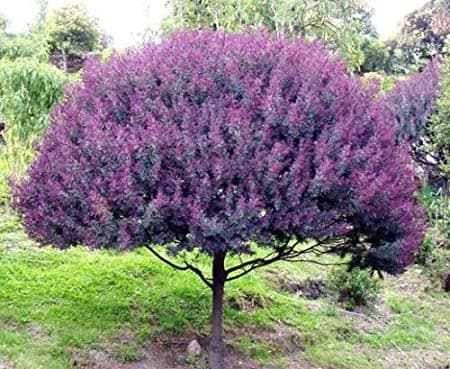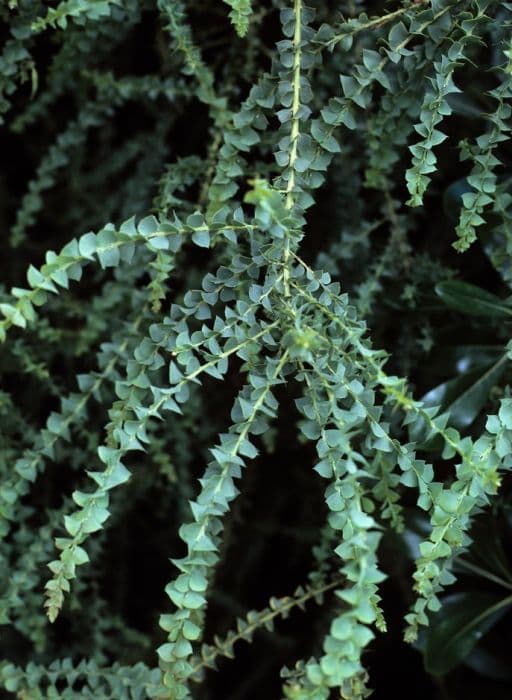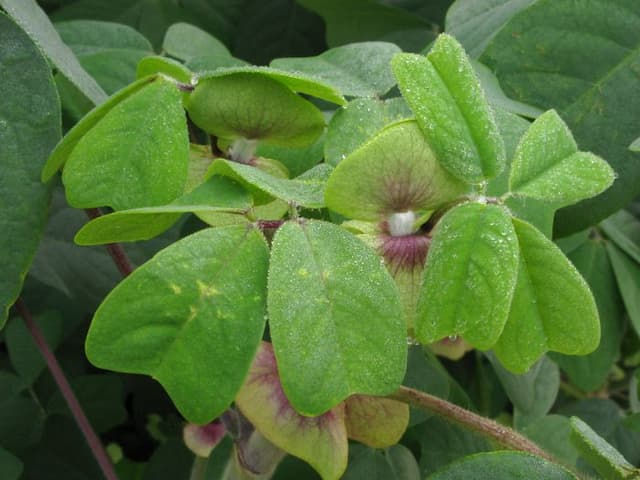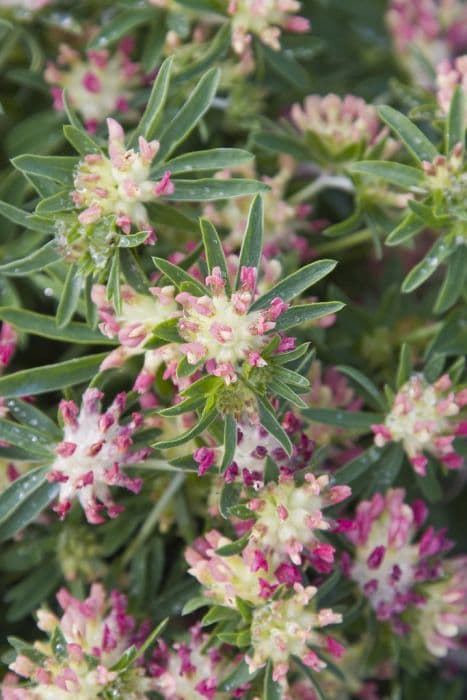Burkwood Broom Cytisus 'Burkwoodii'

ABOUT
Cytisus 'Burkwoodii', commonly known as Burkwood Scotch Broom, is a flowering plant with a rounded habit and is well-regarded for its vibrant display. It has slender, green branches that are somewhat arching and bear small, trifoliate leaves that are green in color, giving it a fine-textured appearance when observed closely. Spring brings an abundance of flowers to the Burkwood Scotch Broom, with blooms that adorn the branches densely. The flowers are pea-like in structure, which is characteristic of the plants in this family, showcasing a classic palette of deep pink and crimson with a hint of a yellow flash at the throat, providing a striking contrast against the green foliage. These blossoms emit a delightful fragrance that adds to the sensory attraction of the shrub. When not in bloom, the Burkwood Scotch Broom maintains visual interest with its slim stems and delicate foliage, creating a feathery look that sways gracefully with the breeze. Despite its delightful and dainty appearance, this cultivar is appreciated for its toughness and resilience once established.
About this plant
 Names
NamesSynonyms
Burkwood Broom, Burkwood's Broom, Scotch Broom.
Common names
Cytisus 'Burkwoodii'
 Toxicity
ToxicityTo humans
The Scotch Broom, which is the common name for Cytisus 'Burkwoodii', contains toxic alkaloids, particularly sparteine and is cytisine, which can be toxic to humans if ingested. The symptoms of poisoning from Scotch Broom include nausea, vomiting, and diarrhea. In severe cases, it may lead to dizziness, confusion, an abnormal heart rhythm, and possibly convulsions. Professional medical advice should be sought if ingestion is suspected.
To pets
The Scotch Broom is toxic to pets due to the presence of alkaloids such as sparteine and cytisine. If a pet ingests parts of the Scotch Broom, it could experience similar symptoms of poisoning as in humans, such as vomiting, diarrhea, and abdominal discomfort. More severe toxicity can lead to lethargy, tremors, seizures, and potential cardiac issues. If you suspect your pet has ingested this plant, immediate veterinary attention is advised.
 Characteristics
CharacteristicsLife cycle
Perennials
Foliage type
Deciduous
Color of leaves
Green
Flower color
Pink
Height
5 feet (1.5 meters)
Spread
5 feet (1.5 meters)
Plant type
Shrub
Hardiness zones
5
Native area
Europe
Benefits
 General Benefits
General Benefits- Aesthetic Appeal: Cytisus 'Burkwoodii', commonly known as Scotch Broom, features attractive dark green foliage and vibrant flowers, which can add beauty and color to gardens and landscapes.
- Attracts Pollinators: The flowers of the Scotch Broom attract bees and butterflies, which are essential for pollination.
- Drought Tolerance: Once established, Scotch Broom is drought-resistant, making it suitable for xeriscaping and areas with limited water availability.
- Low Maintenance: Scotch Broom requires minimal care once established, needing only occasional pruning to maintain its shape and encourage flowering.
- Adaptability: This plant can thrive in a wide range of soils, except those that are very wet, and it can tolerate maritime exposure.
- Erosion Control: Scotch Broom's root system helps to stabilize soil, preventing erosion on slopes and banks.
- Fast Growth: This plant grows quickly and can provide swift coverage and visual interest in a short period.
- Seasonal Interest: With its springtime blossoms and evergreen foliage, Scotch Broom provides year-round interest in the landscape.
- Wildlife Habitat: Dense growth can provide shelter for birds and small wildlife within a garden setting.
 Medical Properties
Medical PropertiesThis plant is not used for medical purposes.
 Air-purifying Qualities
Air-purifying QualitiesThis plant is not specifically known for air purifying qualities.
 Other Uses
Other Uses- Insect Habitat: Scotch Broom provides a nesting ground or habitat for various insects, including beneficial bees which are essential for pollination.
- Soil Erosion Control: Its root system can help stabilize soil on slopes and prevent erosion, making it a potential choice for ecological landscaping purposes.
- Tannin Source: The bark of Scotch Broom can be a source of tannins, which may be used in the leather tanning industry or as a dye fixative.
- Dye Production: Scotch Broom's flowers can be used to produce a yellow dye, historically used for dyeing textiles.
- Witchcraft: In folklore, Scotch Broom was sometimes used in witchcraft for protection and purification rituals.
- Garden Bonsai: Due to its growth habit and attractive flowers, Scotch Broom can be cultivated as a bonsai plant for ornamental purposes.
- Fiber: The fibrous stems of Scotch Broom have been used historically in textile production or for making brooms and brushes.
- Perfumery: The flowers of Scotch Broom may be used in the perfume industry for their fragrant scent.
- Photography: An interesting subject for photographers, particularly when in bloom, it can be featured in gardens and natural habitat photography.
- Fish Poison: Historically, compounds from the plant were sometimes used as a piscicide, a substance to poison fish, by indigenous peoples.
Interesting Facts
 Feng Shui
Feng ShuiThe Burkwood Broom is not used in Feng Shui practice.
 Zodiac Sign Compitability
Zodiac Sign CompitabilityThe Burkwood Broom is not used in astrology practice.
 Plant Symbolism
Plant Symbolism- Cleansing: Scotch broom (a relative of Cytisus 'Burkwoodii') was historically used to make brooms, hence the name. It symbolizes sweeping away old habits and negative energies to bring in new, positive beginnings.
- Protection: Due to its dense growth, Scotch broom is often associated with shelter and protection. It can symbolize an individual’s desire to safeguard what is dear to them.
- Resilience: Cytisus 'Burkwoodii' is known for its hardiness and ability to thrive in poor soils and tough conditions. It is a symbol of resilience, adaptability, and perseverance.
- Humility: Despite its bright and attractive flowers, Cytisus 'Burkwoodii' remains a relatively simple and unassuming plant, often symbolizing humility and modesty.
 Water
WaterScotch Broom should be watered deeply and thoroughly to ensure the root system receives adequate moisture, usually requiring about 1 gallon of water per plant every week during its active growth in spring and summer. During the dormant season in fall and winter, reduce watering to every two to three weeks, allowing the soil to dry out slightly between waterings. Water early in the morning to reduce evaporation and provide the best chance for the water to reach deep into the soil. Overwatering should be avoided as it can lead to root rot; well-draining soil will help prevent this. Adjust the frequency based on rainfall and check the soil moisture to gauge when watering is necessary.
 Light
LightScotch Broom thrives in locations where it can receive full sunlight for most of the day, which means at least six hours of direct, unfiltered sun exposure. An east-west oriented spot that receives morning and afternoon sun is ideal. Avoid shady areas, as insufficient light can lead to poor flowering and a leggy growth habit.
 Temperature
TemperatureScotch Broom prefers a temperate climate and can typically tolerate temperatures as low as 20 degrees Fahrenheit and as high as 80 degrees Fahrenheit. Ideal growing conditions for Scotch Broom are between 50 to 75 degrees Fahrenheit. Protect from extreme cold by mulching around the base in winter if temperatures frequently dip below the hardiness threshold.
 Pruning
PruningPrune Scotch Broom immediately after flowering to maintain its shape and encourage bushy growth. Typically, this means pruning in mid to late spring. Remove any dead or weak branches and cut back about one-third of the plant to stimulate new growth. Scotch Broom should be pruned annually for best results, and for large-scale size reduction, it can be done every few years.
 Cleaning
CleaningNot needed
 Soil
SoilScotch broom (Cytisus 'Burkwoodii') thrives in a well-draining soil mix with a pH of 6.0 to 7.5. The ideal soil mixture can be made of two parts loam, one part peat or compost, and one part sand or perlite for drainage. It's important to provide a soil environment that doesn't retain excessive water to prevent root rot.
 Repotting
RepottingScotch broom typically doesn't need frequent repotting as it is often grown as an outdoor shrub. If grown in containers, repotting can be done every 2 to 3 years, in the spring, when the plant has outgrown its current pot or the soil has degraded.
 Humidity & Misting
Humidity & MistingScotch broom prefers average outdoor humidity levels. It is quite adaptable and tolerates fluctuating atmospheric humidity conditions, thriving in the varying humidity levels of temperate climates without the need for specific adjustments.
 Suitable locations
Suitable locationsIndoor
Provide full sun, well-draining soil, and room to grow.
Outdoor
Plant in full sun, ensure soil drainage, avoid overwatering.
Hardiness zone
6-8 USDA
 Life cycle
Life cycleThe Scotch Broom 'Burkwoodii' begins its life cycle as a seed, which requires a period of stratification to break dormancy before it can germinate. Upon germination in early spring, the seedling develops a taproot and rapidly grows into a shrub with green, slender, and densely branched stems. Over the years, it enters a vegetative stage where it matures and establishes itself, developing compound leaves that are trifoliate (composed of three leaflets). The plant reaches reproductive maturity typically within 2 to 3 years, flowering in late spring to early summer with showy pink and red leguminous flowers that attract pollinators. After pollination, the plant produces seed pods that mature by late summer, eventually bursting open to disperse seeds. The shrub has a relatively short lifespan and may live for about 10 to 15 years, after which it senesces and dies, thereby completing its life cycle.
 Propogation
PropogationPropogation time
Spring-Early Summer
Propogation: Scotch Broom 'Burkwoodii', a shrub known for its vibrant flowers and fine foliage, is typically propagated in late winter to spring before new growth starts. The most popular method is through semi-hardwood cuttings. To do this, one must cut a 4 to 6-inch long piece (approximately 10 to 15 centimeters) from the current season's growth, ensuring the cutting has a few leaf nodes. The lower leaves are removed and the base of the cutting is dipped in rooting hormone to encourage root development. Then, the cutting is placed in a well-draining potting mix, ensuring at least one leaf node is below the soil surface. The container is kept under a light misting regime or covered with a plastic bag to maintain high humidity levels while the cutting roots, which usually takes a few weeks. Once roots are established, the new Scotch Broom plants are hardened off before being planted out.









